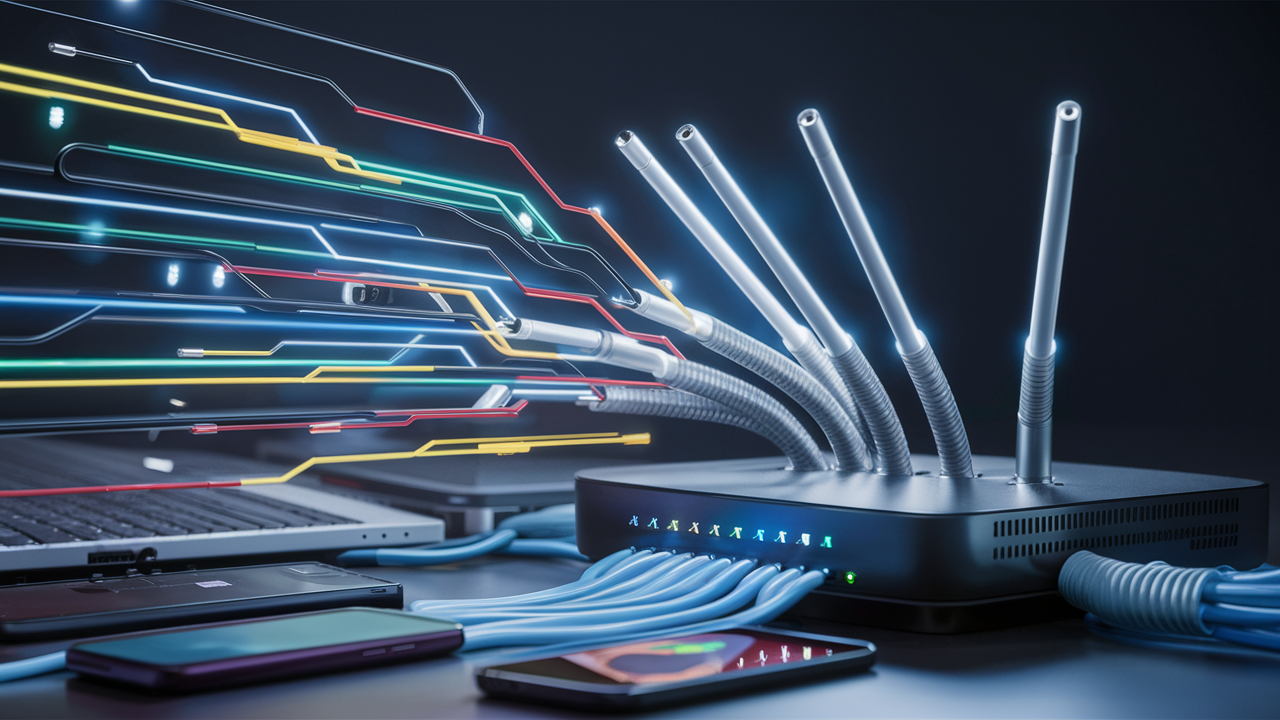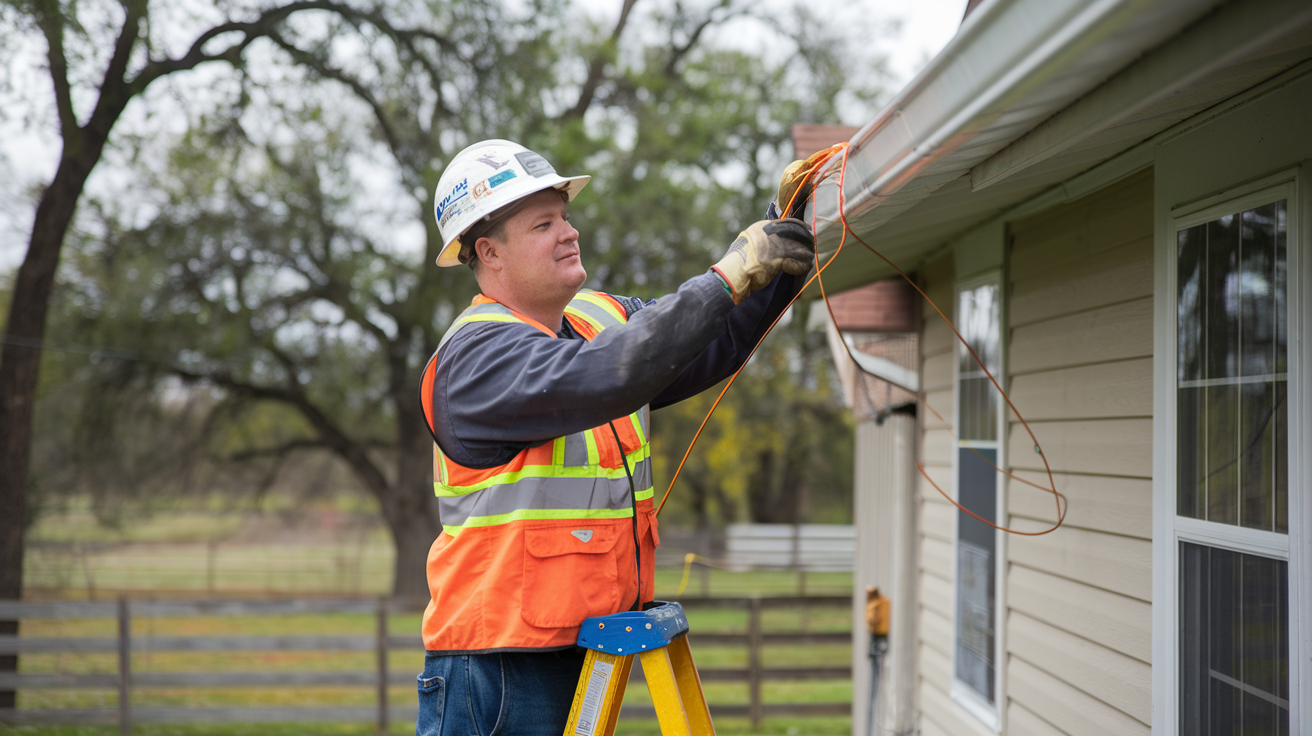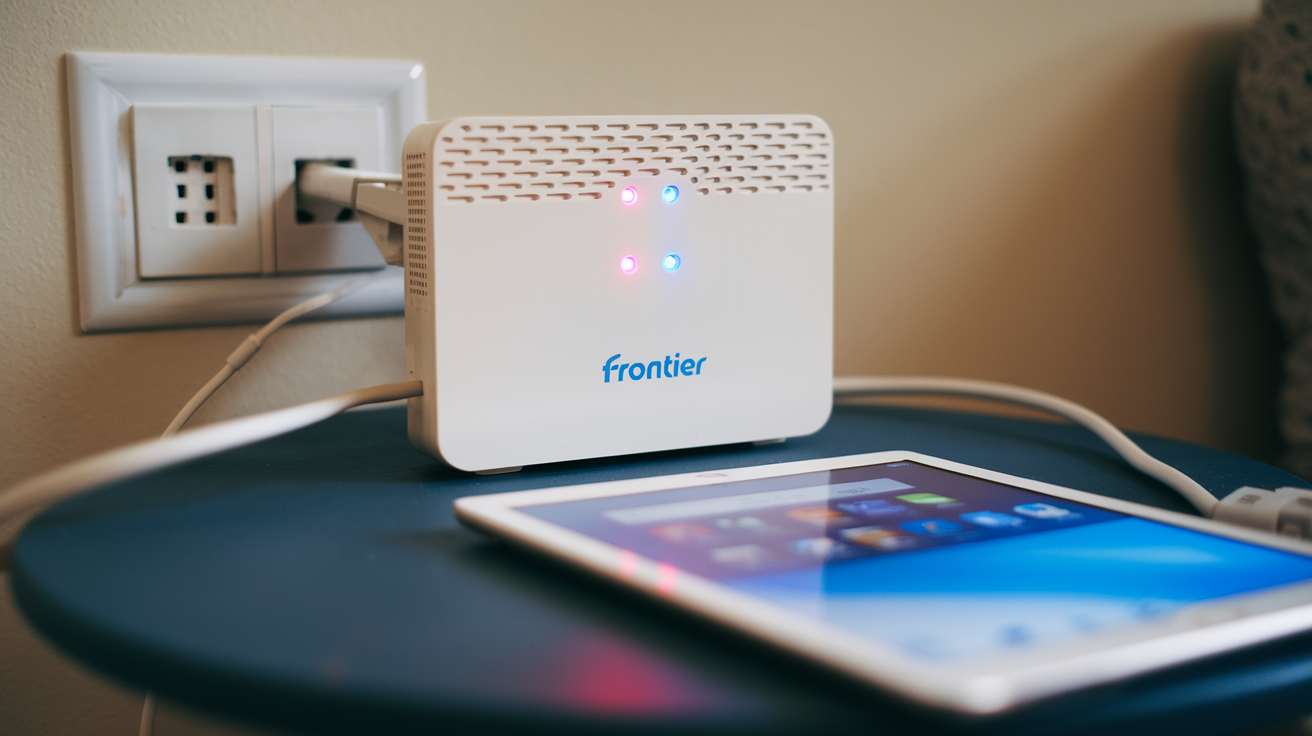
Frontier Fiber Internet offers a cutting-edge, high-speed broadband experience powered by pure fiber-optic technology. Designed for the modern digital lifestyle, it promises unparalleled reliability, symmetrical upload and download speeds, and a future-proof connection for everything from streaming 8K video to supporting multiple smart home devices simultaneously. Discover if Frontier Fiber is the right upgrade for your home.
What is Frontier Fiber Internet?
Frontier Fiber Internet is a broadband service provided by Frontier Communications that utilizes a pure fiber-optic network to deliver internet connectivity directly to homes and businesses. Unlike traditional cable or DSL internet, which often rely on copper wiring for the final leg of the connection, Frontier Fiber uses strands of glass or plastic to transmit data as pulses of light. This fundamental difference in infrastructure is what enables Frontier Fiber to offer significantly higher speeds, lower latency, and greater reliability.
In 2025, the demand for robust internet connections has never been higher. With the proliferation of high-definition streaming, online gaming, remote work, video conferencing, and an ever-increasing number of connected smart home devices, a standard internet connection can quickly become a bottleneck. Frontier Fiber aims to solve these modern connectivity challenges by providing a future-proof solution that can handle the most demanding online activities with ease. It's not just about faster downloads; it's about a more responsive, stable, and seamless online experience for every member of the household.
How Fiber Optics Work: The Science Behind the Speed
To truly understand the advantage of Frontier Fiber Internet, it's essential to grasp the underlying technology: fiber optics. This revolutionary method of data transmission offers a stark contrast to the copper-based infrastructure that has historically dominated internet service.
The Core Principle: Light, Not Electricity
At its heart, fiber optic internet transmits data using pulses of light. Thin strands of glass or plastic, each thinner than a human hair, form the cables. These strands are incredibly pure and are designed to guide light signals over long distances with minimal loss of signal strength or degradation.
From Data to Light Pulses
When you send data, such as requesting a webpage or uploading a file, your modem or router converts this digital information (binary code of 0s and 1s) into light pulses. These pulses are then sent through the fiber optic cable. Different patterns and intensities of light represent different data packets. At the receiving end, another device converts these light pulses back into digital data that your computer or device can understand.
Advantages Over Copper Wiring
Copper wires, used in DSL and older cable internet technologies, transmit data using electrical signals. This method is inherently limited by several factors:
- Signal Degradation: Electrical signals weaken significantly over distance, requiring repeaters or boosters that can introduce latency and reduce speed.
- Interference: Copper wiring is susceptible to electromagnetic interference (EMI) from other electrical devices, power lines, and even weather conditions, leading to dropped connections and inconsistent speeds.
- Bandwidth Limitations: Copper has a finite capacity for carrying electrical signals, which translates to a ceiling on the maximum speeds achievable.
Fiber optics, by contrast, are largely immune to these issues:
- Minimal Signal Loss: Light signals can travel much longer distances through fiber optic cables with negligible signal degradation.
- Immunity to Interference: Since light is used, fiber optic cables are not affected by EMI, ensuring a cleaner and more stable signal.
- Vastly Higher Bandwidth: The capacity of light to carry information is orders of magnitude greater than electrical signals on copper, allowing for speeds that are exponentially faster and scalable to future demands.
The "Last Mile" Matters
Many internet providers offer "fiber-to-the-node" (FTTN) or "fiber-to-the-building" (FTTB) services. In these scenarios, fiber optic cable runs to a neighborhood cabinet or building, but the final connection to your home still uses traditional copper wiring. This means the benefits of fiber are diminished by the limitations of the copper. Frontier Fiber, however, is committed to providing "fiber-to-the-home" (FTTH) or "fiber-to-the-premises" (FTTP). This means the fiber optic cable runs all the way from Frontier's network directly into your residence, ensuring you receive the full, uncompromised benefits of fiber optic technology.
Frontier Fiber Plans and Pricing (2025)
Frontier Communications offers a range of fiber internet plans designed to cater to different household needs and budgets. While specific pricing and plan availability can vary by location, the core offerings in 2025 generally revolve around symmetrical download and upload speeds. This is a key differentiator for fiber internet, meaning your upload speeds are as fast as your download speeds, which is crucial for activities like video conferencing, uploading large files, and live streaming.
Understanding Symmetrical Speeds
Traditional internet plans often have significantly slower upload speeds than download speeds. For example, a 100 Mbps download plan might only offer 10 Mbps upload. This imbalance can lead to frustration when trying to participate in video calls, upload content to social media or cloud storage, or play online games that require quick data transmission. Frontier Fiber's symmetrical speeds mean a 500 Mbps download plan also offers 500 Mbps upload, providing a balanced and robust connection for all online activities.
Typical Frontier Fiber Plans (Illustrative Examples for 2025)
It's important to check Frontier's official website for the most accurate and up-to-date plan details in your specific area. However, here are common tiers you might find:
| Plan Name (Example) | Download Speed | Upload Speed | Monthly Price (Estimated) | Best For |
|---|---|---|---|---|
| Frontier Fiber 500 | 500 Mbps | 500 Mbps | $50 - $65 | Small to medium households, heavy streaming, moderate gaming, remote work. |
| Frontier Fiber 1 Gig | 1 Gbps (1000 Mbps) | 1 Gbps (1000 Mbps) | $70 - $85 | Larger households, power users, intense online gaming, 4K/8K streaming, multiple simultaneous users. |
| Frontier Fiber 2 Gig | 2 Gbps (2000 Mbps) | 2 Gbps (2000 Mbps) | $90 - $110 | Extremely demanding households, professionals working with large files, advanced home networking, future-proofing. |
Note: Prices are estimates and may not include taxes, fees, equipment rentals, or promotional discounts. Installation fees may also apply.
Factors Influencing Pricing
- Speed Tiers: Higher speeds naturally come with higher monthly costs.
- Promotional Offers: Frontier often runs introductory offers for new customers, which can significantly reduce the monthly price for the first 12-24 months.
- Contract Length: Some plans might require a contract, while others are month-to-month. Contracts can sometimes lock in lower prices.
- Bundling: While Frontier's primary focus is fiber internet, in some areas, they might offer bundles with TV or phone services, which could affect the overall cost.
- Equipment Fees: While Frontier typically provides a modem/router, there might be an option to purchase your own or pay a monthly rental fee.
Tips for Choosing a Plan
- Assess Your Usage: How many people use the internet in your home? What do you primarily use it for (streaming, gaming, working, browsing)?
- Consider Future Needs: Technology is constantly evolving. Choosing a slightly higher speed than you think you need now can future-proof your connection.
- Check Availability: Not all plans are available in every location. Use Frontier's online tool to verify what’s offered in your area.
- Read the Fine Print: Understand any potential fees, contract terms, and data caps (though fiber plans are typically unlimited).
For the most precise information, it is always recommended to visit the official Frontier Fiber Internet page or contact their sales department directly.
Key Features and Benefits of Frontier Fiber
Frontier Fiber Internet isn't just about speed; it's about a superior internet experience characterized by several key features and benefits that set it apart from older technologies. These advantages directly translate into a more seamless, productive, and enjoyable online life.
1. Blazing-Fast Speeds
This is the most obvious benefit. Frontier Fiber offers speeds that are significantly faster than traditional cable or DSL. In 2025, gigabit (1000 Mbps) and even multi-gigabit speeds (2 Gbps and beyond) are becoming increasingly common with fiber. This means:
- Instantaneous Downloads: Download large files, movies, or game updates in seconds rather than minutes or hours.
- Buffer-Free Streaming: Enjoy 4K and even 8K video streaming on multiple devices simultaneously without any buffering or interruptions.
- Rapid Web Browsing: Web pages load almost instantly, making browsing a much smoother experience.
2. Symmetrical Upload and Download Speeds
As mentioned previously, this is a critical advantage. With symmetrical speeds, your upload performance matches your download performance. This is invaluable for:
- High-Quality Video Conferencing: Participate in crystal-clear video calls for work or personal connections without lag or pixelation.
- Content Creation and Uploading: Professionals and hobbyists can upload large video files, photos, or project data to cloud services or platforms much faster.
- Online Gaming: While download speed is important for game downloads, upload speed (and low latency) is crucial for responsive gameplay.
- Live Streaming: Stream your own content in high definition without dropping frames or experiencing a choppy feed.
3. Unmatched Reliability and Stability
Fiber optic cables are far less susceptible to environmental factors and interference than copper wires:
- Immunity to Electromagnetic Interference (EMI): Unlike copper, fiber doesn't pick up interference from appliances, power lines, or other electronic devices, leading to a more stable connection.
- Weather Resistance: Fiber is less affected by moisture, temperature fluctuations, and other weather-related issues that can plague copper networks.
- Reduced Downtime: The inherent robustness of fiber optic technology generally leads to fewer service interruptions and greater overall network uptime.
4. Low Latency
Latency, often referred to as "ping," is the time it takes for data to travel from your device to a server and back. Fiber optics excel in this area:
- Responsive Online Gaming: Lower latency means quicker reaction times in fast-paced online games, giving you a competitive edge.
- Seamless Video Calls: Reduced delay between speakers in video conferences makes conversations feel more natural and less disjointed.
- Real-time Applications: Crucial for remote surgery, high-frequency trading, or any application where split-second response times are critical.
5. Future-Proof Technology
Fiber optic infrastructure is built for the future. The capacity of fiber is so immense that it can be upgraded to even higher speeds simply by changing the equipment at either end of the cable, without needing to replace the physical fiber itself. This means your Frontier Fiber connection is less likely to become obsolete as internet demands continue to grow.
6. Unlimited Data (Typically)
Most Frontier Fiber plans come with unlimited data, meaning you don't have to worry about hitting data caps or incurring overage charges, even with heavy usage like streaming 4K video or downloading large files.
7. Enhanced Smart Home Capabilities
With the increasing number of smart home devices (thermostats, security cameras, smart speakers, lighting, etc.), a robust internet connection is essential. Frontier Fiber provides the bandwidth and stability to ensure all your devices can operate smoothly and reliably without slowing down your network.
Frontier Fiber vs. Traditional Internet Technologies
Understanding the differences between Frontier Fiber and other common internet technologies is crucial for making an informed decision. The underlying infrastructure dictates the performance, reliability, and future-proofing of your internet connection. Here’s a comparison:
Frontier Fiber vs. DSL (Digital Subscriber Line)
DSL uses existing copper telephone lines to transmit data. While it's widely available, its performance is highly dependent on the distance from your home to the telephone company's central office.
- Speed: Fiber is exponentially faster. DSL speeds can range from a few Mbps to around 100 Mbps in ideal conditions, but often much lower, especially at greater distances. Fiber offers gigabit speeds and beyond.
- Symmetry: DSL typically has very slow upload speeds, often 1/10th or less of the download speed. Fiber offers symmetrical speeds.
- Reliability: DSL is prone to interference from electrical signals and degrades significantly over distance. Fiber is highly resistant to interference and maintains speed over long distances.
- Latency: DSL generally has higher latency than fiber, making it less ideal for real-time applications.
Frontier Fiber vs. Cable Internet
Cable internet uses coaxial cables (the same ones used for cable TV) to deliver internet service. It's a significant upgrade from DSL but still has limitations compared to fiber.
- Speed: Fiber offers higher top-end speeds and more consistent performance. While cable can offer gigabit speeds, these are often shared bandwidth within a neighborhood, meaning speeds can slow down during peak usage times when many neighbors are online. Fiber speeds are dedicated to your home.
- Symmetry: Cable internet typically has much slower upload speeds than download speeds. Fiber offers symmetrical speeds.
- Reliability: Cable networks can be affected by network congestion in the neighborhood and are more susceptible to interference than fiber. Fiber is generally more reliable.
- Latency: Fiber typically offers lower latency than cable internet, which is important for gaming and real-time communication.
- Infrastructure: Cable internet is a shared medium. If your neighbors are all streaming 4K video simultaneously, your speed might be impacted. Fiber is a dedicated connection to your home.
Frontier Fiber vs. Satellite Internet
Satellite internet uses a satellite dish to connect to a satellite in orbit, which then communicates with a ground station. It's often the only option in very rural or remote areas where wired infrastructure is unavailable.
- Speed: Fiber is vastly superior in speed. Satellite speeds can be slow, often in the range of 25-100 Mbps, and are highly variable.
- Symmetry: Satellite upload speeds are extremely slow. Fiber offers symmetrical speeds.
- Reliability: Satellite internet is heavily impacted by weather conditions (rain, snow, clouds) and can experience significant outages. It also suffers from very high latency due to the vast distance the signal must travel. Fiber is far more reliable and has low latency.
- Data Caps: Satellite plans almost always have strict data caps, leading to throttling or extra charges for exceeding them. Fiber plans are typically unlimited.
- Latency: Satellite internet has extremely high latency (often 500ms or more), making it unsuitable for real-time applications like online gaming or even smooth video conferencing. Fiber latency is typically under 20ms.
Frontier Fiber vs. 5G Home Internet
5G Home Internet is a newer technology that uses wireless 5G cellular signals to provide home internet. It offers a wireless alternative to wired connections and can be a good option in areas where wired upgrades are slow to arrive.
- Speed: Fiber generally offers higher and more consistent speeds, especially multi-gigabit options. 5G speeds can vary significantly based on signal strength, network congestion, and your proximity to a tower. While 5G can be fast, it's often not as consistently high as fiber.
- Symmetry: 5G upload speeds are typically lower than download speeds, though better than DSL or cable. Fiber remains the leader in symmetrical performance.
- Reliability: 5G performance can be affected by signal obstructions (buildings, trees) and network congestion, similar to mobile phone service. Fiber's wired connection is inherently more stable and less prone to external interference.
- Latency: 5G latency is significantly lower than 4G and can be competitive with fiber in some scenarios, but fiber often maintains an edge for ultra-low latency applications.
- Availability: 5G Home Internet is expanding rapidly but is still limited by the rollout of 5G infrastructure. Fiber availability is also geographically dependent but represents a more permanent infrastructure upgrade.
Summary Table: Frontier Fiber vs. Other Technologies
| Feature | Frontier Fiber | DSL | Cable Internet | Satellite Internet | 5G Home Internet |
|---|---|---|---|---|---|
| Technology | Fiber Optics (Light) | Copper Phone Lines (Electricity) | Coaxial Cable (Electricity) | Satellite Dish (Radio Waves) | Wireless 5G (Radio Waves) |
| Max Speeds (Typical 2025) | 1 Gbps - 5 Gbps+ | Up to 100 Mbps (often less) | Up to 1 Gbps (shared) | 25 - 100 Mbps | 100 Mbps - 1 Gbps (variable) |
| Upload Speeds | Symmetrical (Same as Download) | Very Slow | Significantly Slower than Download | Extremely Slow | Slower than Download |
| Reliability | Excellent | Fair (Distance/Interference Sensitive) | Good (Congestion Sensitive) | Poor (Weather/Line-of-Sight Sensitive) | Fair to Good (Signal/Congestion Sensitive) |
| Latency | Very Low | Moderate | Low to Moderate | Very High | Low to Moderate |
| Data Caps | Typically Unlimited | Often Capped | Often Capped | Almost Always Capped | Often Capped |
| Future-Proofing | High | Low | Moderate | Low | Moderate |
In conclusion, Frontier Fiber stands out as the superior option for speed, reliability, and future-proofing due to its pure fiber-optic infrastructure. While other technologies have their place, fiber offers the most robust and capable internet experience available today.
Frontier Fiber Availability and Installation Process
One of the most significant considerations when looking into Frontier Fiber Internet is its availability. Fiber optic networks are expensive and time-consuming to build, meaning Frontier Fiber is not yet available in all areas. However, Frontier is actively expanding its fiber footprint across the United States.
Checking Availability
The first and most crucial step is to determine if Frontier Fiber is available at your specific address. Frontier provides several ways to do this:
- Online Availability Checker: The easiest method is to visit the official Frontier website and use their address lookup tool. You'll typically find this prominently displayed on their internet service page.
- Phone Consultation: You can call Frontier's sales department directly and provide your address to a representative who can check their network maps.
- Local Representatives: In some areas undergoing new fiber builds, local sales representatives or door-to-door canvassers might be present.
Availability can change rapidly as Frontier continues to invest in infrastructure upgrades. What might not be available today could be an option in the near future. It's worth checking periodically if your area isn't currently served.
The Installation Process: What to Expect
Once you've confirmed availability and signed up for a plan, the next step is installation. Frontier Fiber installations typically involve a professional technician visiting your home. Here’s a general overview of the process:
1. Scheduling the Appointment
After signing up, you'll work with Frontier to schedule an installation appointment. You'll usually be given a date and a time window (e.g., between 8 AM and 12 PM). It’s important to ensure someone over 18 is present for the entire duration of the appointment.
2. Site Survey and Planning
Upon arrival, the technician will assess your property and discuss the best placement for the equipment. They will determine the optimal route for the fiber optic cable to enter your home and where the Optical Network Terminal (ONT) and Wi-Fi router will be installed. The ONT is a small device that converts the optical signal into an electrical signal your router can use.
3. Running the Fiber Optic Cable
This is often the most involved part. The technician will need to run a thin fiber optic cable from the nearest network access point (e.g., a utility pole or underground box) to your home. This might involve:
- Aerial Installation: If existing aerial infrastructure is available, the cable might be run from a pole to your house.
- Underground Installation: In many newer developments or areas where underground utilities are preferred, the cable will be buried. This might involve trenching or directional boring to minimize disruption to your yard.
- Interior Routing: Once the cable enters your home, the technician will route it neatly to the designated equipment location. They are trained to minimize visible wiring and ensure a clean installation.
4. Installing Equipment
The technician will install the ONT, usually mounted on an interior wall. They will then connect your Frontier-provided Wi-Fi router to the ONT. They will ensure the equipment is powered on and functioning correctly.
5. Testing and Activation
The technician will perform speed tests and connectivity checks to ensure your service is active and performing according to the plan you selected. They will verify that your Wi-Fi network is broadcasting and accessible.
6. Setup and Walkthrough
The technician will typically walk you through the basic setup of your Wi-Fi network, including the network name (SSID) and password. They may also offer guidance on connecting your devices and using the Frontier portal or app for managing your account.
What You Need to Provide
- Access: Ensure the technician has clear access to the exterior of your home and the interior areas where the cable and equipment will be installed.
- Power Outlets: The ONT and router will require power, so ensure there are accessible electrical outlets nearby.
- Clearance: While technicians are professional, having the areas around potential installation points clear can help speed up the process.
Installation Timeframe
A standard Frontier Fiber installation typically takes between 2 to 4 hours. However, complex installations, such as extensive trenching or difficult routing, could take longer. The technician will usually provide an estimate before they begin.
It's important to note that Frontier aims for minimal disruption. They are generally very good about cleaning up after themselves and restoring any disturbed landscaping as neatly as possible.
Is Frontier Fiber Right for Your Household?
Deciding if Frontier Fiber Internet is the best choice for your home involves evaluating your current internet needs, considering your household's usage patterns, and understanding the benefits fiber offers compared to your existing service. In 2025, with the increasing reliance on digital connectivity, fiber is becoming the gold standard for many.
Who Benefits Most from Frontier Fiber?
Frontier Fiber is particularly advantageous for:
- Heavy Streamers: If your household frequently streams movies, TV shows, or live sports in HD, 4K, or even 8K, the high bandwidth and stability of fiber will eliminate buffering and ensure a premium viewing experience.
- Online Gamers: Low latency and symmetrical speeds are critical for competitive online gaming. Frontier Fiber provides the responsiveness needed for fast-paced games, reducing lag and improving reaction times.
- Remote Workers and Students: High-speed, reliable internet is essential for productivity. Crystal-clear video conferencing, quick access to cloud-based documents, and stable connections for virtual meetings are all hallmarks of fiber.
- Large Households with Multiple Users: When many people are using the internet simultaneously for different activities (streaming, gaming, browsing, video calls), fiber's capacity prevents slowdowns and ensures everyone gets a good experience.
- Content Creators and Uploaders: The symmetrical upload speeds mean you can upload large video files, backups, or project assets to cloud services significantly faster than with traditional internet.
- Smart Home Enthusiasts: As more devices become connected, the demand on your internet increases. Fiber provides the bandwidth and stability to support a growing ecosystem of smart home gadgets without performance issues.
- Those Seeking Future-Proofing: Investing in fiber today means you're prepared for the internet demands of tomorrow, which are only expected to increase with advancements in technology.
- Users Frustrated with Current Service: If you frequently experience slow speeds, buffering, dropped connections, or inconsistent performance with your current provider, Frontier Fiber is likely to be a substantial upgrade.
When Might Frontier Fiber Not Be the Best Fit?
While fiber is excellent, it might not be the optimal choice for everyone in every situation:
- Extremely Light Internet Users: If your household primarily uses the internet for occasional email checks and very basic web browsing, and you have no plans to increase your usage, a lower-tier DSL or cable plan might suffice. However, the price difference for entry-level fiber plans is often minimal, making fiber a compelling option even for light users.
- Limited Availability: The most significant barrier is availability. If Frontier Fiber is not offered in your specific location, you'll need to consider other providers or technologies.
- Budget Constraints (Potentially): While Frontier often has competitive introductory pricing, the higher-tier gigabit and multi-gigabit plans can be more expensive than basic plans from other providers. However, when comparing equivalent speeds and features, fiber often offers better value.
Making the Decision: Key Questions to Ask Yourself
- What are my current internet pain points? (e.g., slow downloads, buffering, lag)
- How many devices are connected to my network simultaneously?
- What are our primary internet activities? (e.g., streaming, gaming, working from home, video calls)
- What upload speeds do I need? (Consider video conferencing, cloud backups, content creation)
- Is Frontier Fiber available at my address?
- What is the long-term cost? (Consider introductory offers versus standard pricing)
- What is the reliability of my current service versus what Frontier Fiber promises?
By honestly answering these questions, you can determine if the robust capabilities of Frontier Fiber align with your household's digital lifestyle. For most users in 2025 seeking a high-performance, reliable internet connection, Frontier Fiber is an excellent choice.
Troubleshooting and Support for Frontier Fiber Customers
While Frontier Fiber is known for its reliability, like any technology, occasional issues can arise. Frontier provides customer support channels and resources to help you troubleshoot common problems and get assistance when needed.
Common Troubleshooting Steps for Internet Issues
Before contacting support, try these basic steps, which resolve many common internet problems:
- Reboot Your Equipment: This is the most common fix. Unplug the power cords from both your Frontier modem (ONT) and your Wi-Fi router. Wait for about 30-60 seconds, then plug the modem back in first. Wait for it to fully boot up (lights stabilize), then plug in your router. Wait for it to boot up.
- Check Physical Connections: Ensure all cables (power cords, Ethernet cables connecting the ONT to the router, and any cables from the router to your devices) are securely plugged in at both ends. Look for any visible damage to cables.
- Test with a Wired Connection: If you're experiencing Wi-Fi issues, try connecting a computer directly to the router using an Ethernet cable. If the wired connection works fine, the problem is likely with your Wi-Fi signal or router settings.
- Check for Outages: Frontier may be experiencing a service outage in your area. You can often check this via their website or app, or by calling their automated support line.
- Test Speed: Use a reliable speed test website (like Speedtest.net or Frontier's own speed test tool) to check your current download and upload speeds. Compare these results to the speeds you are supposed to be getting.
- Restart Your Device: Sometimes, the issue isn't with the internet but with the device you're using. Try restarting your computer, smartphone, or tablet.
Frontier Customer Support Channels
If the basic troubleshooting steps don't resolve your issue, Frontier offers several ways to get help:
- Online Support Center: Frontier's website typically features a comprehensive support section with FAQs, troubleshooting guides, video tutorials, and articles specific to their fiber services. This is often the quickest way to find answers to common questions.
- MyFrontier App: Many customers find the MyFrontier mobile app to be a convenient tool for managing their account, checking for outages, and accessing support resources.
- Phone Support: For more complex issues or if you prefer to speak with a representative, you can call Frontier's customer service line. The number is usually found on your bill or on their website. Be prepared to provide your account information.
- Live Chat: In some cases, Frontier may offer live chat support through their website, allowing you to communicate with a support agent in real-time via text.
When to Contact Frontier Support
You should contact Frontier support if:
- You have tried the basic troubleshooting steps, and your internet is still not working.
- You are experiencing consistently slow speeds that do not match your plan.
- Your service is dropping frequently.
- You suspect a problem with Frontier's equipment (ONT).
- You have questions about your billing or account that cannot be resolved through the app or website.
Tips for Efficient Support Interactions
- Have Your Account Information Ready: This includes your account number and the service address.
- Describe the Problem Clearly: Be specific about what is happening, when it started, and what troubleshooting steps you have already taken.
- Note Any Error Messages: If you see any error codes or messages on your devices or equipment, write them down.
- Be Patient: Support lines can sometimes be busy.
Frontier aims to provide reliable service, and their support team is there to assist you in resolving any issues that may arise, ensuring you can continue to enjoy the benefits of your fiber internet connection.
The Future of Internet with Frontier Fiber
The landscape of internet technology is constantly evolving, driven by increasing demands for speed, capacity, and responsiveness. Frontier Fiber Internet, built on the foundation of fiber optics, is not just a solution for today's needs but a strategic investment in the future of connectivity. As we look ahead to the next decade and beyond, the advantages of fiber become even more pronounced.
Increasing Bandwidth Demands
The trend towards higher bandwidth consumption is undeniable. In 2025, 4K streaming is commonplace, and 8K content is becoming more accessible. Virtual and augmented reality (VR/AR) experiences are moving from niche applications to mainstream entertainment and productivity tools, requiring massive amounts of data. The Internet of Things (IoT) continues to expand, with billions of devices communicating and sharing data. Frontier Fiber's inherent capacity to deliver multi-gigabit speeds and its scalability mean it is well-equipped to handle these escalating demands without requiring a complete overhaul of the physical infrastructure.
The Rise of Immersive Technologies
Technologies like VR, AR, and the metaverse promise to revolutionize how we interact, work, and play. These applications are incredibly data-intensive and latency-sensitive. Fiber optics, with their ultra-low latency and vast bandwidth, are the only viable infrastructure capable of supporting these immersive digital experiences seamlessly. Frontier Fiber provides the foundation for a future where digital and physical realities can merge more fluidly.
Advancements in Smart Homes and Cities
The concept of the "smart home" is rapidly evolving into "smart cities." From intelligent traffic management systems and connected public utilities to advanced home automation and remote healthcare monitoring, these interconnected systems rely on robust, high-speed communication networks. Fiber optic infrastructure, like that deployed by Frontier, is essential for enabling the reliable data flow required for these sophisticated urban and domestic environments.
The Importance of Symmetrical Speeds
As the digital economy grows, the distinction between consuming and creating content blurs. More individuals and businesses are engaging in activities that require significant upload bandwidth, such as live streaming, video production, cloud-based collaboration, and remote diagnostics. Frontier Fiber's commitment to symmetrical speeds ensures that users are not limited by their upload capacity, empowering them to participate fully in the creator economy and advanced digital workflows.
Frontier's Commitment to Fiber Expansion
Frontier Communications has made significant investments in expanding its fiber optic network. This ongoing commitment signifies their belief in the long-term viability and superiority of fiber technology. As they continue to upgrade and build out their fiber footprint, more communities will gain access to the benefits of this future-proof internet solution. This expansion is crucial for bridging the digital divide and ensuring that more households can access the high-performance internet necessary for modern life and future innovation.
In essence, choosing Frontier Fiber Internet in 2025 is not just about getting faster internet today; it's about future-proofing your home or business against the ever-increasing demands of the digital world. It's an investment in a reliable, high-performance connection that will continue to serve your needs for years to come, enabling you to embrace new technologies and opportunities as they emerge.
Conclusion:
In summary, Frontier Fiber Internet represents the pinnacle of modern broadband technology, leveraging the unparalleled capabilities of fiber optics to deliver exceptional speed, unwavering reliability, and low latency. For households and businesses in 2025 grappling with the demands of high-definition streaming, immersive online gaming, remote work, and an ever-growing ecosystem of connected devices, Frontier Fiber offers a transformative solution. Its symmetrical upload and download speeds are a game-changer for content creators and collaborators, while its inherent stability ensures a seamless online experience for all users. While availability remains a key factor, Frontier's ongoing expansion efforts are bringing this superior connectivity to more communities. By understanding the core technology, comparing it against traditional alternatives, and assessing your household's unique needs, it becomes clear that Frontier Fiber is not just an upgrade—it's a strategic investment in a future-proof digital life. If Frontier Fiber is available in your area, it is a highly recommended choice for anyone seeking the best possible internet performance and reliability.






